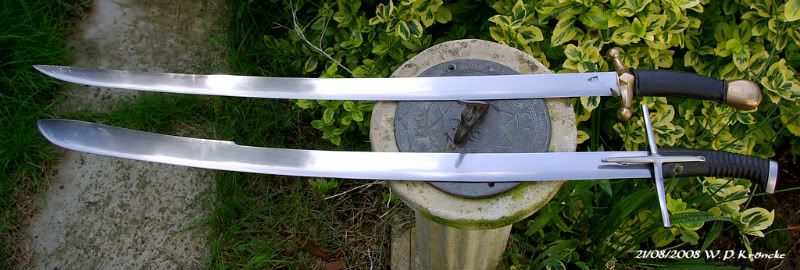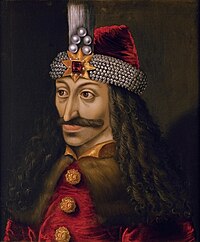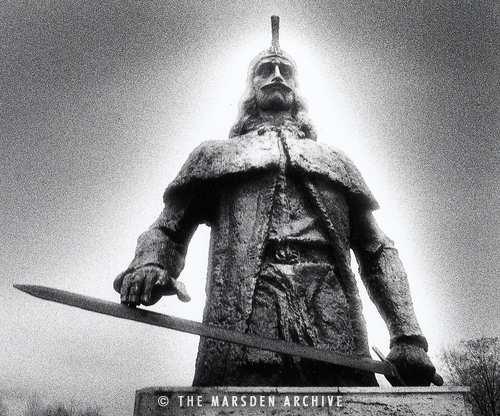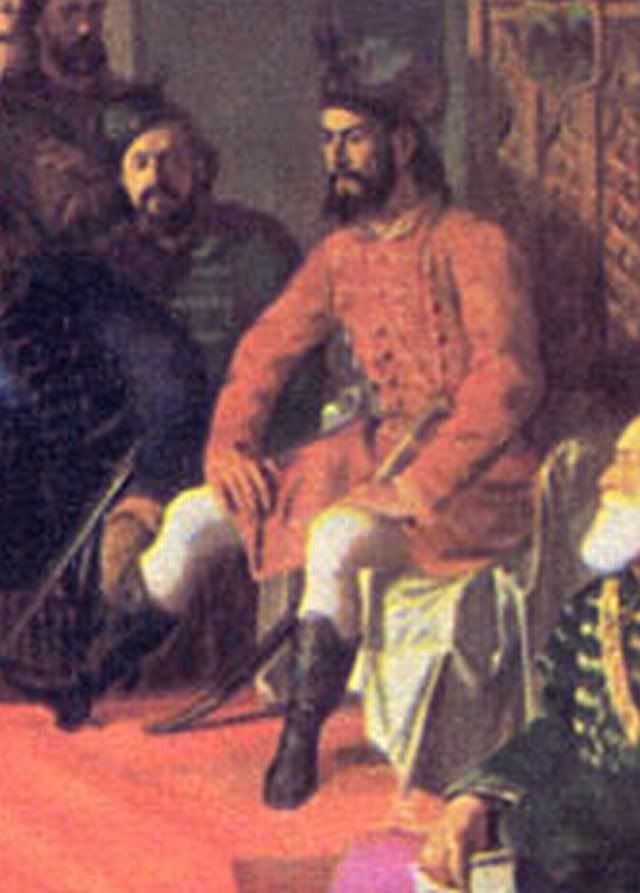
 |
|
|
|
|
#1 |
|
Arms Historian
Join Date: Dec 2004
Location: Route 66
Posts: 9,957
|
Recently I received a query concerning interest in what type of sword might have been carried by Vlad III, who is of course more recognized for his inspiration for the fictional character of Bram Stoker, Dracula.
In trying to learn more on this, I decided that the title I have used might keep things more focused on the topic of the weapons, without being drawn into the psuedo Gothic pop culture perspective more commonly associated with this historical figure. Apparantly Vlad (1431-1476) was the son of Vlad Dracul, whose name 'Dracul' derived from his appointment to the somewhat secretive fraternal Order of the Dragon in 1431. This rather elite organization for rulers and high officials was essentially derived from and in league with other military orders such as the Tuetonic Knights, Hospitallers et al. and apparantly begun by the Hungarian Holy Roman Emperor Sigismund in 1408. The appointment of Vlad (the senior) to Dracul took place in Nuremberg. It should be noted that Wallachia in these times was profoundly settled by Saxons, and trade activity was accordingly with German merchants in its major cities. It would seem that it would be most likely that the swords of the Wallachian forces would likely have come from the weapons producers of Germany, and consisted of knightly weapons associated with heavy armored European style warfare. Also, the swords of Byzantine Bulgaria may have also been prevalent. However, the question seems to be, would Vlad III, Dracula, the son, have used a sabre? While the Ottomans had taken the Bulgarian regions, it seems important to try to establish when the sabre became prominantly in use by the Ottomans, and would Vlad III have adopted its use. So far I have found that the form was 'recognizable' by the end of the 15th century, and that Hungarian sabres, whose form derived from Ottoman sabres were not actually seen until the 16th century. I have not found any evidence of any sword attributed to Vlad III, although we have had visits to museums in Transylvania and others shared here it seems in past years. I'd like to know what others think on this, and of anyone is aware of any sword in any museum attributed to, or if the type possibly used, by Vlad III. All best regards, Jim |
|
|

|
|
|
#2 |
|
Member
Join Date: Mar 2006
Location: Room 101, Glos. UK
Posts: 4,186
|
did we not have a discussion about regional sabres, ie. hungarian (magyar) ones existing in the 9th c.? i seem to recall seeing some museum exhibits of the same. i remember as i have a couple of modern repro magyar sabres
from the 9c & 16c. & the 9c museum ones looked much like corroded versions of mine...which actually came from hungary and made by a hungarian swordsmith.  vlad would likely have had a bit fancier one i suspect. the yelmanned one at the bottom was supposedly an early 16c magyar, so would only have been a few decades after he was killed, there must have been some transitioning style in between. the man himself:  as he was incarcerated by the king of hungary, only to wind up marrying one of his daughters as his second wife, (he died in battle with the turks a couple of years later) he would have been very familiar with the magyar sabres of the period. as he hated the turk with a passion, he would be less likely to use a turkish format weapon...none of the various paintings of him from the period that i've seen show him with a weapon. ah, yes found the thread here i think the sabre in the posts by matchlock & tvv just before your terminal post looks like one vlad would have been happy with. seems to be nicknamed 'the charlemagne' or the 'attila' sword. maybe it's really the vlad sword 
Last edited by kronckew; 12th July 2009 at 12:01 AM. |
|
|

|
|
|
#3 |
|
Arms Historian
Join Date: Dec 2004
Location: Route 66
Posts: 9,957
|
Hi Kronckew,
Thank you so much for responding and for finding these threads. I seem to be getting worse at finding things.......good one on the 'terminal' thread!!  LOL! I seem to have a lot of those.....just call me the terminator....oh well, a guys gotta get the last word in somewhere. LOL! I seem to have a lot of those.....just call me the terminator....oh well, a guys gotta get the last word in somewhere. Those truly are beautiful sabres, especially the Magyar. I have always thought these early Hungarian sabres were incredibly attractive, and somehow though I thought they were earlier, it seems these are believed to descend from the Turkish forms of the 16th century. Vlad was killed in 1476. Most of what I can find seems to suggest that if Wallachia was so prevalently occupied by Saxons, there was strong German trade, and the Order of the Dragon was a Germanic order focused on heavily armoured knights, then Germanic arming broadswords were plausibly used. In one museum in Transylvania there is an example of one of these broadswords of the general type, must find the post (I think Radu posted it). These are seen in "Cut and Thrust Weapons" (Wagner, plate 24) hexagonal cross section pommel, cross guard in reversed S shape, straight broadsword, captioned Germanic c.1450. Others are also simple crossguard knightly broadswords. The only substance I can find that would suggest the use of a sabre of this Hungarian/Turkish form would be that Vlad was assisted in recovering his rule by the Hungarians the same year of his death, 1476. If the use of these sabres extended that far back, rather than the 16th century that seems generally held, it might be possible. I know it is a common misconception that throughout the Crusades, the Saracens all wielded deeply curved sabres, though it is known that mostly the swords were simple crossguard straight broadswords, similar to those of the European crusaders. There were however some curved swords, the European falchions more a heavy blade with radiused edge. It is unclear to me what type curved swords the Muslim forces might have had. Thank you for posting this Kronckew!! Those are beauties, and as you say, perhaps it is the 'Vlad' sword.......thanks also for the portrait of the 'Prince of Darkness'  All the best, Jim |
|
|

|
|
|
#4 |
|
Member
Join Date: Mar 2006
Location: Room 101, Glos. UK
Posts: 4,186
|
dates are always confusing me, 1476 is the last quarter of the 15th century and only 24 years from the 16th century - which starts in 1500, so i had lept at the assumption that the changes over that short a period would not have been great. wallachia had been under mongol rule until the early 1300's (14th century) when hungary took over, so curved mongolian style swords would possibly be familiar objects. the area involved:
 found this partial image of a statue of him holding a sword that is straight however. not found any details on the date of the statue  this one shows vlad recieving turkish envoys, seems to show him wearing a sabre very like the charlemagne/attilla/9c kronckew repro.  again, no date info on painting, may have been dramatic license of a later artist. national gallery bucharest. cropped/sharpened section:  he has a mace in this one /Staue_Prinz-Vladgros.jpg) edited:found a better photo, shows a sword this one looks to be fairly recent, no sword visible, is that his coat of arms? /Pfaehlungen_Vlad_Draculea.jpg) of course attempts to photograph him in later years after his death were unsuccessful as his image cannot be photographed or seen in a mirror  (i personally suspect that as his head was removed and sent to the turkish sultan in instanbul, where it was displayed, fittingly, impailed on a spike, that his transformation into a classical vampire would have been impossible. severing the head (or spine) was one of the traditional ways to kill one. he would have made a great headless horseman tho, ichabod crane would have loved to meet him) Last edited by kronckew; 12th July 2009 at 08:03 AM. |
|
|

|
|
|
#5 |
|
Member
Join Date: Dec 2004
Location: Bay Area
Posts: 1,625
|
Approximately at the same time Vlad III ruled Wallachia, in neighboring Moldova ruled Stefan the Great, whose sword is currently in the Top Kapi armoury in Istanbul.
Courtesy of Micha Hofmann in the MyArmoury forums, I was able to find the following image, which I think shows the sword quite well. Too bad the Ottomans did not decide to keep one of Vlad's swords as a memento of him, it would have helped us a lot. David Nicolle wrote a book on the region's arms and armor for Osprey, titled something like "Hungary and the Fall of the Eastern Roman Empire", which may contain some insight in the arms used in Wallachia in the 15th century. Regards, Teodor |
|
|

|
|
|
#6 |
|
Member
Join Date: Mar 2006
Location: Room 101, Glos. UK
Posts: 4,186
|
as mentioned, this all was going on around the time of the fall of the roman empire, which ended with the fall of byzantium/constantinople in 1453 (name changed officially to 'istanbul' in 1930 - the turks called it mostly constantinople (Kostantiniyye in turkish) tho some called it istanbul or other variants).
constantinople was defended by 7000 odd men in 1453, mostly venetian and genoese mercenaries against 80,000 turks, mehmet used siege artillery to batter down it's formidable walls. as the sons of the then emperor fled, and the remaining free roman states were not conquered till 1460, one could argue that as the date of the final fall, or even 1503 when the last graeco-roman 'emperor' died. quite a mix of cultures and weapons in the area in the latter half of the 15th c. this event is seen as the end of the dark ages, and the start of renaissance europe as the populace that fled spread byzantine culture throughout europe. wheelocks are thought to have been invented around 1500, wonder if ol' vlad may have had a beta copy for evaluation from one of the techie geeks of the age. Last edited by kronckew; 12th July 2009 at 10:05 AM. |
|
|

|
 |
|
|